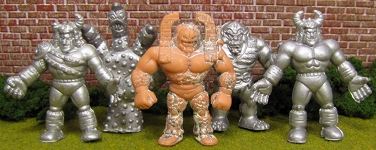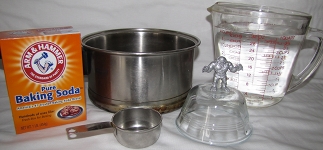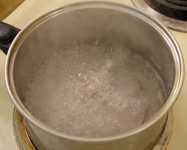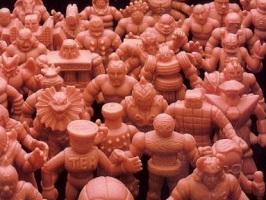M.U.S.C.L.E. collectors often have their own personal techniques, tips, and preference for cleaning figures. An often-mentioned method of reshaping figures and removing paint is the boiling method, which is simply placing the figure in boiling water for a variable amount of time.
When the Silver Boat Paint figures, part of the Purple Claw Project, were first shared with the community boiling the figures was one of the methods suggested. As Environmental Sciences evolved, boiling the figure was again suggested as a method for cleaning the figure. The method seemed too basic if the goal was to remove boat paint plus primer from a M.U.S.C.L.E. figure.
However, the goal was to remove the paint as unobtrusively as possible and nothing seemed more basic than water. There was still a nagging belief that boat paint would be especially resistant to water. It seemed prudent to introduce an additional cleaning agent. Baking soda was a simple and effective cleaning agent that can be used on everything from cleaning vegetables to cleaning grills or even putting out fires.A quick Google search resulted in a simple recipe that appeared to be the best option. This recipe seemed to balance the simplicity that was desired with boiling, while still introducing a more corrosive cleaning solution.
EXPERIMENTThe original recipe, which can be seen here, called for two ingredients: (1) ¼ cup baking soda; and (2) 1 quart of water.
An old pot was selected to boil the figure because the results of the experiment were unknown. It allowed for the pot to be thrown away at the end of the experiment. Additionally old tongs, spoons, and anything involved with the experiment were also used so they too could be thrown away.
Once all of the equipment was collected, the 1-quart of water was boiled on the stove. When the water reached a rolling boil the ¼ cup of baking soda was added. The solution was stirred until the baking soda completely dissolved, and the figure was added. It was left to soak in the boiling solution for 20 minutes.
After 20 minutes the figure was removed, inspected, and some supplemental cleaning methods were introduced. The figure was scrapped, picked, and scrubbed. These additional methods were added somewhat impulsively after the figure exited the solution with less paint and primer removal than expected.RESULTS
The results of the boiling method plus baking soda were less than impressive.
The figure was no longer completely covered in silver boat paint. However, the figure was still nearly covered in the white primer. The unknown type of black paint, which was used to write “PAWN” on the back of the figure, was seemingly left undamaged by the process.
The primer did not appear to be greatly effected by the boiling solution. Had supplemental cleaning methods (scrapping, picking, scrubbing) not be used, than the figure would have been almost completely covered in white primer.
It could be argued that the boiling method was very effective in removing the paint and making the primer susceptible to scrubbing and scrapping. Unfortunately the figure would need to be kept warm and moist by continually placing it back into the solution if the scrubbing and scrapping was going to be effective.Additionally, when the figure was removed from the boiling solution it was incredibly flexible. Once it had cooled it returned to its normal, minimal elasticity.
CONCLUSION
This method was only moderately effective for removing boat paint and primer from a M.U.S.C.L.E. figure. The paint was removed, but the primer was nearly completely intact after boiling. Any further clean up would have to be completed nearly immediately or by keeping the figure in a “boiled state.” The boiling method did not seem to leave the primer extraordinarily softened for further clean up.
– Double the recipe.
After 20 minutes there had been substantial evaporation and the figure was not entirely covered.
– Use the largest pot available.
When baking soda is added to boiling water it will bubble up or “flare up.” To avoid spills the pot needs to contain not only the boiling water but hold in all the bubbling mess that will be created.
– Use disposable equipment.
In this experiment the paint and primer left an odd residue on the pot, utensils, glass bowls, and anything that touched the solution or boiled figure. Throw away anything that was involved in boiling the figure (i.e., spoons, pots, etc.)
– Be careful.
Conduct the experiment away from children and animals. When the baking soda is added to the boiling water the “flare up” could make a large mess or worse.
Further experiments with boiling M.U.S.C.L.E. figures could prove beneficial – depending on the type of paint used on the figure.








#1 by Johnny on November 10, 2010 - 2:07 am
Kids, don’t try this at home! Ha ha ha!
#2 by Brandon on November 10, 2010 - 5:14 pm
Amusing video, but I was really hoping for better results. I’m a bit surprised at how little impact it seemed to have. I guess my complete lack of experience with boat paint has left me ill equipped to properly assess the situation.
Hmmm….where to go from here?
#3 by Chad Perry on November 10, 2010 - 5:40 pm
Don’t worry, the next experiment had much more interesting results!
#4 by SmokinGun on November 17, 2010 - 2:32 pm
I dont like the looks of this. Theres gonna be some damage to the figure itself.
Im no expert on paint supplies. But tried soaking the figure in paint thinner for a few days. Maybe that might help loosing some of the paint on those hard to reach areas, like the small details of the figure.
#5 by Chad Perry on November 18, 2010 - 11:12 am
I can assure you that boiling the figure did not damage the figure at all. I think it may look damaged to you because it was so ineffective at removing the paint and primer.
The problem with something like paint thinner is that it tends to be very harsh – which is more likely to damage the figure.
I tried nail polish remover on another silver boat paint figure years ago. It was fantastic at removing the paint, but utterly destroyed the figure.